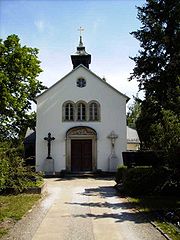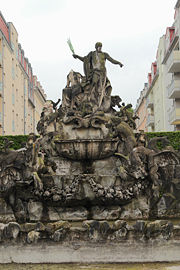
Friedrichstadt (Dresden)
Encyclopedia

Dresden
Dresden is the capital city of the Free State of Saxony in Germany. It is situated in a valley on the River Elbe, near the Czech border. The Dresden conurbation is part of the Saxon Triangle metropolitan area....
, Germany. A factory district in the late 19th and early 20th centuries, it is known as the home of the founders of the artistic association known as Die Brücke
Die Brücke
Die Brücke was a group of German expressionist artists formed in Dresden in 1905, after which the Brücke Museum in Berlin was named. Founding members were Fritz Bleyl, Erich Heckel, Ernst Ludwig Kirchner and Karl Schmidt-Rottluff. Later members were Emil Nolde, Max Pechstein and Otto Mueller...
.
History
Once known as Ostra, a Sorbian village going back to the year 1206, it was then turned into a manor farm for the electorPrince-elector
The Prince-electors of the Holy Roman Empire were the members of the electoral college of the Holy Roman Empire, having the function of electing the Roman king or, from the middle of the 16th century onwards, directly the Holy Roman Emperor.The heir-apparent to a prince-elector was known as an...
's residence in Dresden. Augustus II the Strong
Augustus II the Strong
Frederick Augustus I or Augustus II the Strong was Elector of Saxony and King of Poland and Grand Duke of Lithuania ....
of Saxony
Electorate of Saxony
The Electorate of Saxony , sometimes referred to as Upper Saxony, was a State of the Holy Roman Empire. It was established when Emperor Charles IV raised the Ascanian duchy of Saxe-Wittenberg to the status of an Electorate by the Golden Bull of 1356...
renamed the area Neustadt in 1730. This Neustadt should not to be confused with the neighborhood in Dresden now known as Neustadt
Neustadt, Dresden
Neustadt in Dresden or Dresden-Neustadt may refer to:* Innere Neustadt , a district of Dresden* Äußere Neustadt, a district of Dresden* both districts taken together as a whole* Dresden-Neustadt railway station...
, then called Neue Königstadt. In 1731, the people of Neustadt again renamed their settlement, this time to Friedrichstadt after Augustus the Strong's son, future elector Frederick Augustus II, known in German as Friedrich August II.
After the dawn of the Industrial Revolution
Industrial Revolution
The Industrial Revolution was a period from the 18th to the 19th century where major changes in agriculture, manufacturing, mining, transportation, and technology had a profound effect on the social, economic and cultural conditions of the times...
, the city declared Friedrichstadt a factory district in 1878. The plight of the factory workers in this area became a common theme in the works of the artists of Die Brücke, who set up a studio in a former cobbler's shop.
A good deal of the Friedrichstadt was destroyed in the bombing
Bombing of Dresden in World War II
The Bombing of Dresden was a military bombing by the British Royal Air Force and the United States Army Air Force and as part of the Allied forces between 13 February and 15 February 1945 in the Second World War...
on 13–14 February 1945. Many of the neighborhood's attractions have been rebuilt since then.
Today Friedrichstadt is a mixed industrial, commercial, and residential neighborhood with almost 6,000 residents.
Yenidze
A former cigarette factory built in 1907, now office building and restaurant/biergarten with an excellent view of the Dresden skyline.
Old Catholic cemetery
The oldest grave is from 1724. Contains notable baroqueBaroque
The Baroque is a period and the style that used exaggerated motion and clear, easily interpreted detail to produce drama, tension, exuberance, and grandeur in sculpture, painting, literature, dance, and music...
, roccoco, and neoclassical
Neoclassicism
Neoclassicism is the name given to Western movements in the decorative and visual arts, literature, theatre, music, and architecture that draw inspiration from the "classical" art and culture of Ancient Greece or Ancient Rome...
gravestones. The final resting place of many famous Dresdeners as well as a number of victims of the Nazis.

Palais Brühl-Marcolini and the Fountain of Neptune

Ursula Katharina of Altenbockum
Ursula Katharina of Altenbockum Lubomirska , later Princess of Teschen, was a Polish-German noblewoman and mistress of Augustus the Strong, King of Poland and Elector of Saxony.-Early life:...
, this palace, which now houses the Friedrichstadt hospital, contains Chinese and Pompeii
Pompeii
The city of Pompeii is a partially buried Roman town-city near modern Naples in the Italian region of Campania, in the territory of the comune of Pompei. Along with Herculaneum, Pompeii was destroyed and completely buried during a long catastrophic eruption of the volcano Mount Vesuvius spanning...
-style rooms as well as the neighborhood's most famous fountain, the Fountain of Neptune. Other notable residents included Count Heinrich von Brühl
Heinrich von Brühl
Heinrich, count von Brühl , was a German statesman at the court of Saxony and the Polish–Lithuanian Commonwealth...
and Count Camillo Marcolini
Count Camillo Marcolini
Camillo Count Marcolini-Ferretti was a minister and general director of the fine arts for the Electorate, later Kingdom of Saxony....
. Napoleon also briefly lived in the palace in 1813.

External links
- http://www.dresden-und-sachsen.de/dresden/friedrichstadt.htm "Aus der Geschichte der Friedrichstadt" (in German)
- http://www.dresden.de/de/02/06/05/01/c_05.php A collection of statistics on Friedrichstadt from the official website of the city of Dresden (in German)

